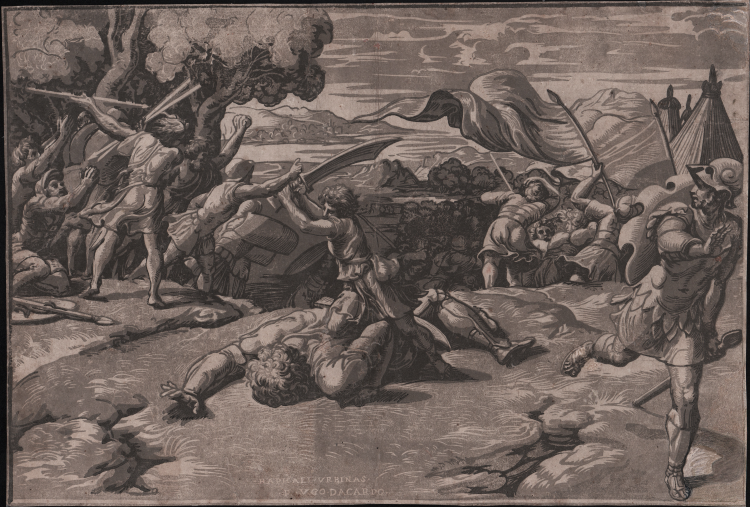




| Reference: | S44164 |
| Author | Ugo da CARPI |
| Year: | 1520 ca. |
| Measures: | 385 x 265 mm |



| Reference: | S44164 |
| Author | Ugo da CARPI |
| Year: | 1520 ca. |
| Measures: | 385 x 265 mm |
Chiaroscuro woodcut from 3 blocks, gray, dark gray and black, circa 1520/27, after Raphael.
Example of the second state of five with the inscriptions “RAPHAEL VRBINAS” and “P. VGO DACARPO” cut from the light tone block in the image.
Magnificent proof of this rare second state, richly toned, printed on contemporary laid paper with "mermaid in circle" watermark, trimmed at marginal line, old perfectly executed restorations at right corners, traces of central vertical crease, otherwise in excellent condition.
This print is based on the engraving by Marcantonio Raimondi (B.XIV.12.10) which in turn is based on a drawing by Raphael.
“David and Goliath, captures the young Israelite shepherd David, with sword raised, about to behead the Philistine giant Goliath, who he has felled with a shot from his sling. Around these central figures, the Israelite and Philistine troops engage in combat. The chiaroscuro is in reverse of Marcantonio Raimondi's engraving, which in all likelihood served as Ugo's direct source. Marcantonio's engraving relates to Raphael's fresco design in the Vatican Loggia. Ugo's three-block chiaroscuro woodcut remained in circulation long enough for the blocks to undergo five state changes and eventually accumulate considerable insect damage.
In the rare first state, the names of the designer “RAPHAEL VRBINAS” and printmaker/publisher “P VGO DA CARPI” are cut in the light tone block, respectively in the top and bottom of the perimeter that frames the composition. In the second state, both names appear together within the image in the bottom center foreground of the light tone block, and the tone block perimeter is cut back. Between the second and third states, the spears held by a combatant at upper left were modified with a plug inserted into the darkest block. Ugo's name is excised from the tone block in the fourth state, while Raphael's name is also removed in the fifth (states four and five must have been printed at a remove from Ugo, for the blocks are overly inked, the inks are inconsistently applied, and the ink palettes and formulation are atypical” (cf. N. Takahatake, The chiaroscuro woodcut in Renaissance Italy pp. 93-94).
Bibliografia
Bartsch A., Le peintre graveur, Vienna, 1803-1821, v. XII, p. 26, n. 8; Chiaroscuro woodcuts from the Frits Lugt Collection in Paris, Tokyo, 2005, pp. 39–40, n. 13 (Hinterding E.); Takahatake N., Niccolò Vicentino's Miraculous Draught of Fishes, in “Print Quarterly”, London, 2011, XVIII, 2011, 3, pp. 256-260, p. 260, n. 24; Takahatake N., Raphael and the chiaroscuro woodcut, in “Raffael als Zeichner. Die Beiträge des Frankfurter Kolloquiums”, 2015, pp. 167-186, pp. 167-168; Takahatake N., The Chiaroscuro Woodcut in Renaissance Italy, Los Angeles, 2018, pp. 93-94, n. 19; Takahatake N., Atlante delle xilografie italiane del Rinascimento, ALU.0945.1.
Ugo da CARPI (Carpi 1480 circa – Bologna 1532)
|
Vasari, the sixteenth-century biographer of Italian artists, claimed that Ugo (about 1450-1525) invented the chiaroscuro (light and shade) woodcut. His claim to the invention of this process has long been contested. Hans Burgkmair and Lucas Cranach were known to have made chiaroscuro prints in the north before 1510, whereas there is no definite evidence of Ugo’s work in this technique until 1516, when he appealed to the Venetian senate for protection from his imitators. Carpi was active in Venice and Rome. Many of his chiaroscuro prints are after drawings by Raphael and Parmigianino. None of his paintings survives.
|
Ugo da CARPI (Carpi 1480 circa – Bologna 1532)
|
Vasari, the sixteenth-century biographer of Italian artists, claimed that Ugo (about 1450-1525) invented the chiaroscuro (light and shade) woodcut. His claim to the invention of this process has long been contested. Hans Burgkmair and Lucas Cranach were known to have made chiaroscuro prints in the north before 1510, whereas there is no definite evidence of Ugo’s work in this technique until 1516, when he appealed to the Venetian senate for protection from his imitators. Carpi was active in Venice and Rome. Many of his chiaroscuro prints are after drawings by Raphael and Parmigianino. None of his paintings survives.
|